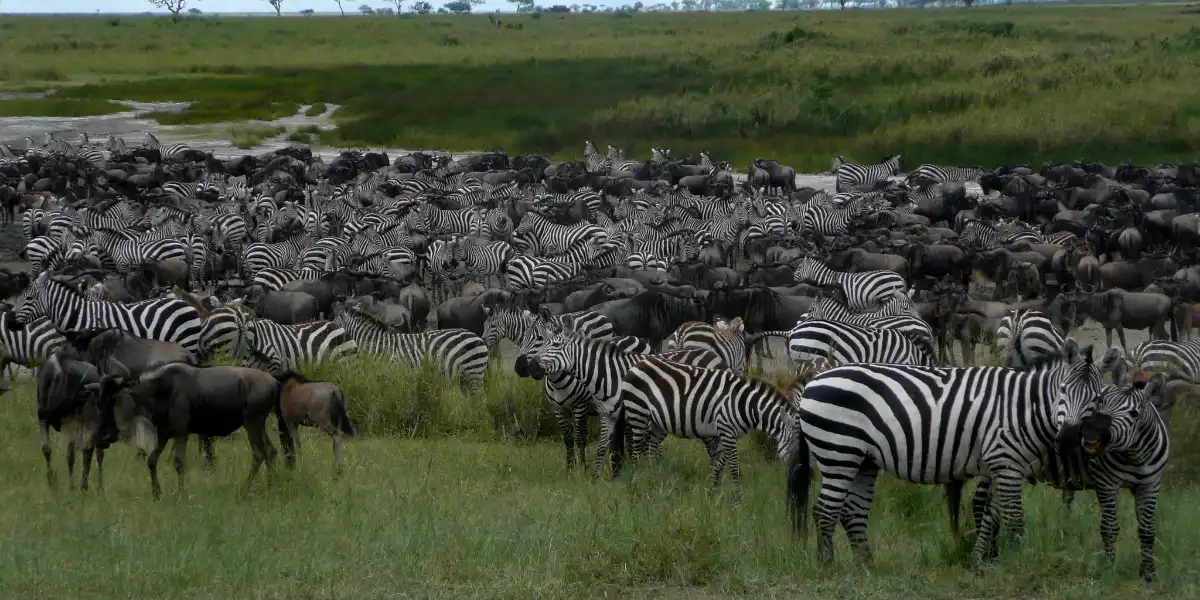.webp)
The great African plains come alive in a spectacle of nature that leaves even the most seasoned travelers in awe—the wildebeest migration. Picture immense herds of wildebeests and zebras embarking on an epic journey across the Serengeti-Mara ecosystem, facing treacherous river crossings and lurking predators. If you've ever dreamed of experiencing this primal event up close, our comprehensive step-by-step guide is here to help you plan the wildebeest migration safari of a lifetime.
The Magic of the Migration
The wildebeest migration isn't just a mere migration; it's a symphony of survival and renewal that unfolds across the African plains. Millions of wildebeests and zebras follow a relentless cycle of movement driven by the search for fresh grazing and water sources. The migration isn't just about the herds; it's about the predators and scavengers that thrive in their wake. Lions, cheetahs, hyenas, and crocodiles all play their part in this grand spectacle of life and death.
Step 1: Research and Destination Selection
Your journey begins with research—immersing yourself in the knowledge of this natural wonder. Understand the migration's seasonal patterns and the ecosystems it traverses. Two primary destinations stand out: the Serengeti National Park in Tanzania and the Maasai Mara National Reserve in Kenya. Both offer unparalleled opportunities to witness the migration, but choosing the right one for you requires careful consideration.
Step 2: Timing Your Safari
Timing is crucial when it comes to the wildebeest migration. The Great Migration, from July to October, sees massive herds traversing the plains and crossing crocodile-infested rivers. The calving season, from January to March, offers a different perspective as newborn calves join the journey. Your timing will determine the experiences you'll be part of—be it heart-pounding river crossings or heartwarming scenes of new life.
Step 3: Choosing Accommodations
Where you rest your head after a day of exhilarating safari adventures matters. Accommodations range from luxury lodges that offer panoramic views to tented camps that bring you closer to the wilderness. Staying within or near the national parks and reserves ensures you're right where the action unfolds. Due to the popularity of migration season, booking accommodations well in advance is advised.
Step 4: Booking Guided Tours
While independent travel is an option, guided tours provide unparalleled insights. Experienced guides bring the ecosystem to life with their knowledge of animal behavior, migration patterns, and local culture. When selecting a tour operator, consider factors such as their reputation, reviews, and the size of the tour group. A well-planned guided tour can enhance your understanding and appreciation of the migration.
Step 5: Preparing for the Safari
As you pack for your adventure, think comfort and practicality. Pack clothing suitable for both warm days and cool nights, sturdy footwear for walks and hikes, and sun protection to shield yourself from the African sun. If photography is your passion, ensure you have your camera equipment and binoculars. Check for necessary vaccinations and travel documents, and remember to respect the environment by adhering to ethical guidelines.
Step 6: The Safari Experience
The moment has arrived—it's time to witness the migration in all its glory. Feel the ground rumble as herds pass by, watch predators in action, and absorb the breathtaking vistas of the savannah. Patience pays off during the quieter moments, as some of the most incredible sights are the result of careful observation. Listen to your guide's expertise and allow yourself to be fully present in this remarkable experience.
Step 7: Capturing Memories
Preserve your adventure through the lens. Capture the majesty of the landscapes, the intimate moments of wildlife, and the camaraderie of fellow travelers. Remember to balance photography with being in the moment—sometimes the most memorable experiences are those etched in your mind. Consider keeping a journal to document your thoughts, emotions, and reflections as you journey through this natural wonder.
Planning a wildebeest migration safari is more than just organizing a trip; it's embarking on a journey that connects you with the primal rhythms of nature. By researching your destination, timing your visit, selecting accommodations wisely, booking guided tours, preparing thoughtfully, immersing yourself fully, and capturing memories, you're creating a mosaic of experiences that will stay with you forever. The wildebeest migration isn't just an event—it's a profound connection to the wild, a story you'll share for years to come.
